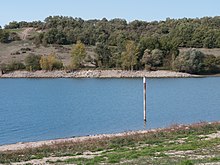Reservoir

A reservoir , also known as a reservoir in Austria , is an artificially created lake that forms in a valley in front of a barrier structure ( dam or dam ). A small reservoir without stable temperature stratification is also called reservoirs, storage pond or storage weiher referred.
Basics
Reservoirs can be divided into two basic groups, on the one hand into stagnant bodies of water , i.e. lakes in the narrower sense, and so-called walkways , i.e. storage areas of the river barriers . The transition is blurred, however, as most of the reservoirs are crossed by a river current. Depending on the hydrographic classification system and the intention of the description, some borderline cases are considered to be a lake or a jam, and thus a section of flowing water .
A reservoir is part of a dam system , which is usually a dam . With shallow rivers, reservoirs can reach dimensions of up to several hundred kilometers. In the mountains and in ravines, large water levels and thus lake depths of up to 300 meters are possible.
In contrast to a natural lake, the water level in a reservoir can fluctuate greatly due to storage management. In certain cases, the storage space can also be completely emptied. Even natural lakes can be expanded in their storage capacity by a weir, such as Lake Victoria - here the transition between the reservoir and water level regulation (for water management and flood protection ) is fluid. Most of the natural lakes, the banks of which are populated, are regulated by outlet weirs during high and low tide (which can also lead to enormous fluctuations in level depending on the lake basin), so they are artificially dammed. The boundaries between natural and artificial water are becoming blurred, so that today the heavily modified water body (EVWK / HMWB ) has been introduced as an intermediate form .
Reservoirs are used as storage for storage power plants , especially pumped storage power plants with additional artificial feedback, as drinking water reservoirs or for agricultural water ( irrigation system ). Also in the fish farming reservoirs are used as fish ponds used, as well as mill ponds and many artificial lakes . A more recent use of reservoirs is the water storage, which is created for the snowmaking system for artificial snow in ski areas. These reservoirs are typically not located in the valley, but higher up, such as on a mountain flank.
See also
- reservoir
- List of the largest reservoirs on earth
- List of reservoirs in Austria
- List of reservoirs in Switzerland
- List of the largest dams on earth
- List of dams in Germany
- List of dams in the world
literature
- Dietrich Uhlmann, Wolfgang Horn: Ecology of reservoirs . In: Biology in our time 36 (2), 2006, ISSN 0045-205X , pp. 92-101.
Web links
Individual evidence
- ↑ For the creation of river networks , lakes are generally ignored and replaced by a water axis flowing through them.
